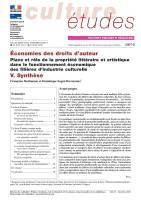Françoise BENHAMOU, Dominique SAGOT-DUVAUROUX
december 2007
16 p.
The digital revolution affects every branch of the cultural industries to varying degrees. It is radically altering the copyright system and the methods for remunerating artistic creation.We are seeing a sort of wild chase among models that are changing incessantly, accompanied by inevitable adjustments in rules and practice. The proportional royalties system, which is difficult to manage and has high associated costs, increasingly coexists with flat rate fees: advances on royalties generally practised in film and television, copyright-free photographs, once-and-for-all payments in the publishing industry, especially for collective works.
At the same time, the growing number of legal licensing arrangements and blanket reproduction agreements are a reflection of new types of organisation geared to developments in the way works are marketed. Works are tending to become common property (non-exclusivity, loss of consumer rivalry), but the complexity and frequent opaqueness of the systems for allocating royalties constitute a major obstacle.
On the Internet, alternative forms of production and distribution exist. They are gradually obliterating the frontier between amateurs and professionals and radically transforming the marketing chain. Works can be recirculated after purchase by someone who is no longer the 'end' consumer.
For the moment, these changes seem to work to the detriment of authors' incomes, and to undercut their bargaining positions within the different branches. This is all the more so since many sectors are, or soon will be, command economies within vertically integrated and outlet-dominated marketing circuits.


